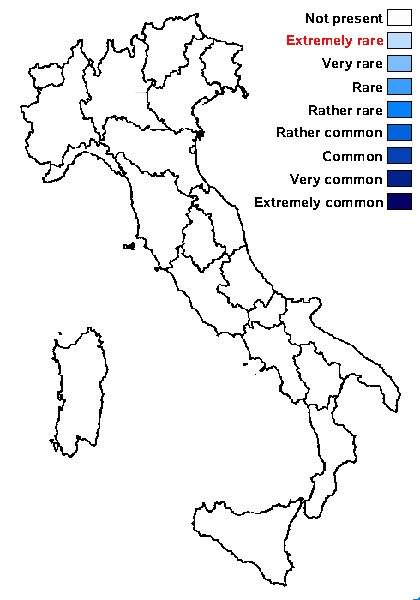Anzina carneonivea (Anzi) Scheid. var. tetraspora Scheid.
Nova Hedwigia, 41, 1-4: 202, 1985
Synonyms:
Distribution:
Description: Thallus crustose, whitish grey, thin, most often thinly episubstratic, c. 200 µm thick, more or less continuous, without a distinct prothallus. Apothecia common, 0.12-0.3 mm across, immersed in thalline warts, initially single, then becoming confluent, with a yellowish-brown to orange, flat disc and a thin, smooth, paler margin. Thalline exciple more or less developed, especially in older apothecia; proper exciple poorly developed, colourless, of periclinally arranged hyphae; epithecium yellowish brown, K-, C+ red, KC+ red; hymenium colourless, I-, K/I-; paraphysoids c. 1.5 µm thick, branched and anastomosing, the apical cells not thickened; hypothecium colourless. Asci 4-spored, subcylindrical, unitunicate, the apex not thickened, I-, surrounded by an amyloid ring and surmounted by a thin amyloid cap, 40-50 µm long. Ascospores 1(-3)-septate, hyaline, ellipsoid to narrowly ellipsoid, thin-walled, with a thin halo, (13.3-)16-20(-21) x 4.4-7 µm. Pycnidia dark, semi-immersed to projecting, 90-160 µm in diam. Conidia short-bacilliform, 3.5-4.5 x c. 0.7 µm. Photobiont chlorococcoid (Asterochloris). Spot tests: thallus K+ yellowish, C-, KC-, P-; apothecia C+ and KC+ red. Chemistry: apothecia with gyrophoric acid (major) and traces of lecanoric acid.Note: this variety, differing in the shorter, 4-spored asci and the larger spores, mainly grows on Rhododendron in the subalpine belt. It is known from several localities in the Central-Eastern Alps (Switzerland, Austria), and should be looked for in the Italian Alps.
Growth form: Crustose
Substrata: bark
Photobiont: green algae other than Trentepohlia
Reproductive strategy: mainly sexual
Poorly known taxon in need of further study

Predictive model
Growth form: Crustose
Substrata: bark
Photobiont: green algae other than Trentepohlia
Reproductive strategy: mainly sexual
Poorly known taxon in need of further study

Predictive model

